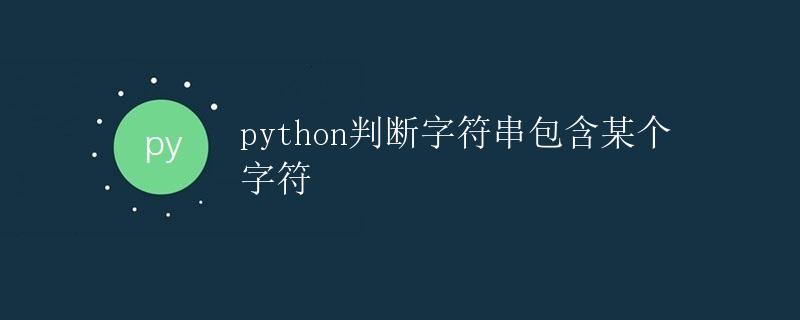Python判断字符串包含某个字符

在日常的编程中,判断一个字符串是否包含某个特定字符是非常常见的操作。Python提供了多种方法来实现这个目的,本文将详细介绍这些方法并给出示例代码。
方法一:使用in关键字
最简单直接的方法是使用Python中的in关键字来判断一个字符串是否包含某个字符。语法如下:
s = "hello world"
char = "l"
if char in s:
print(f"The character '{char}' is in the string.")
else:
print(f"The character '{char}' is not in the string.")
上面的代码中,我们首先定义了一个字符串s和一个字符char,然后使用in关键字来判断char是否在s中。如果在则打印包含的提示,否则打印不包含的提示。
运行结果如下:
The character 'l' is in the string.
方法二:使用count()方法
除了使用in关键字外,我们还可以使用Python字符串的count()方法来统计指定字符在字符串中出现的次数。如果次数大于0,说明字符串包含该字符。示例如下:
s = "hello world"
char = "l"
if s.count(char) > 0:
print(f"The character '{char}' is in the string.")
else:
print(f"The character '{char}' is not in the string.")
运行结果如下:
The character 'l' is in the string.
方法三:使用find()或index()方法
find()和index()方法都是用来查找子字符串在父字符串中的位置,如果找到返回子字符串的起始位置,找不到则返回-1。我们可以利用这一特性来判断字符串是否包含某个字符。示例如下:
s = "hello world"
char = "l"
if s.find(char) != -1:
print(f"The character '{char}' is in the string.")
else:
print(f"The character '{char}' is not in the string.")
运行结果如下:
The character 'l' is in the string.
方法四:使用正则表达式
如果需要更复杂的匹配条件,我们可以使用Python的re模块来使用正则表达式进行字符串匹配。示例如下:
import re
s = "hello world"
char = "l"
if re.search(char, s):
print(f"The character '{char}' is in the string.")
else:
print(f"The character '{char}' is not in the string.")
运行结果如下:
The character 'l' is in the string.
方法五:使用集合
最后一种方法是将字符串转换为集合,然后使用集合操作来判断字符串是否包含某个字符。示例如下:
s = "hello world"
char = "l"
if set(char).issubset(set(s)):
print(f"The character '{char}' is in the string.")
else:
print(f"The character '{char}' is not in the string.")
运行结果如下:
The character 'l' is in the string.
通过以上几种方法,我们可以轻松地判断一个字符串是否包含某个字符。根据实际情况选择合适的方法来进行判断,提高代码的效率和可读性。
 极客笔记
极客笔记